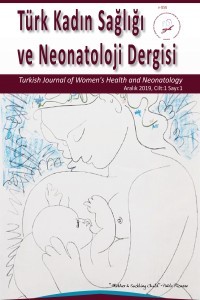Uterusa sınırlı karsinosarkom ve grade 3 endometrioid endometrium kanserinin klinikopatolojik ve sağkalım analizlerinin karşılaştırılması
Endometrioid endometrium kanseri, grade 3, karsinosarkom, yüksek risk, endometrial kanser, rekürrens
Comparison of clinicopathological and survival analysis of uterus confined carcinosarcoma and grade 3 endometrioid endometrium cancer
Endometrioid endometrium cancer, Grade 3, carcinosarcoma, high risk, endometrial cancer, recurrence,
___
- Creasman WT, Morrow CP, Bundy BN, Homesley HD, Graham JE, Heller PB. Surgical pathologic spread patterns of endometrial cancer. A Gynecologic Oncology Group Study. Cancer 1987; 60(8 Suppl):2035-2041.
- Creutzberg CL. GOG-99: ending the controversy regarding pelvic radiotherapy for endometrial carcinoma? Gynecol Oncol 2004; 92:740-743.
- Mariani A, Dowdy SC, Cliby WA ve ark. Prospective assessment of lymphatic dissemination in endometrial cancer: a paradigm shift in surgical staging. Gynecol Oncol 2008; 109:11-18.
- Colombo N, Creutzberg C, Amant F ve ark. ESMO-ESGO-ESTRO Endometrial Consensus Conference Working Group. ESMO-ESGO-ESTRO consensus conference on endometrial cancer: Diagnosis, treatment and follow-up. Radiother Oncol 2015; 117:559-581.
- Vaidya AP, Horowitz NS, Oliva E, Halpern EF, Duska LR. Uterine malignant mixed mullerian tumors should not be included in studies of endometrial carcinoma. Gynecol Oncol 2006; 103:684–687.
- Creasman W. Revised FIGO staging for carcinoma of the endometrium. Int J Gynaecol Obstet 2009; 105:109.
- Bansal N, Herzog TJ, Seshan VE, et al. Uterine carcinosarcomas and grade 3 endometrioid cancers: evidence for distinct tumor behavior. Obstet Gynecol 2008; 112:64-70.
- Zhang C, Hu W, Jia N et al. Uterine carcinosarcoma and high-risk endometrial carcinomas: a clinicopathological comparison. Int J Gynecol Cancer 201; 25:629-636.
- Prueksaritanond N, Chantape W. Comparative Survival Outcomes of UterinePapillary Serous Carcinoma, Clear Cell Carcinoma, Grade 3 EndometrioidAdenocarcinoma, and Carcinosarcoma of Endometrial Cancer in Rajavithi Hospital. J Med Assoc Thai 2016; 99:S75-83.
- Zhu J, Wen H, Bi R, Wu X. Clinicopathological characteristics, treatment and outcomes in uterine carcinosarcoma and grade 3 endometrial cancer patients: a comparative study. J Gynecol Oncol 2016; 27:e18.
- Başlangıç: 2019
- Yayıncı: Sağlık Bilimleri Üniversitesi Etlik Zübeyde Hanım Kadın Hastalıkları Eğitim ve Araştırma Hastanesi
COVID-19 pozitif asemptomatik gebe kadında izole fetal taşikardi
Koray Görkem SAÇINTI, Batuhan ASLAN, Erdal ŞEKER, Mehmet Seçkin ÖZIŞIK, Acar KOÇ
Yenidoğanda COVID-19 Bulaşını Önlemede Etkili Kişisel Koruyucu Ekipman Modeli
Funda AKPINAR, Gülnihal REYHAN TOPTAŞ, Aziz SUREL, Yaprak USTUN
Caner ÇAKIR, Vakkas KORKMAZ, Çiğdem KILIÇ, Dilek YÜKSEL, Mehmet ÜNSAL, Betül TOKGÖZ, Fatih KILIÇ, Sevgi KOÇ, Fulya KAYIKÇIOĞLU, Taner TURAN
Vulvar granular hücreli tümör: Nadir bir olgu sunumu
Çiğdem KILIÇ, Caner ÇAKIR, Dilek YÜKSEL, Alper KARALÖK, Çiğdem MESCİ, Taner TURAN
Servikal patoloji şüphesi ile merkezimize refere edilen hastaların değerlendirilmesi ve yönetimi
Recep ERİN, Kübra BAKİ ERİN, Deniz KULAKSIZ, Yeşim BAYOĞLU TEKİN, Hatice KÜÇÜK
